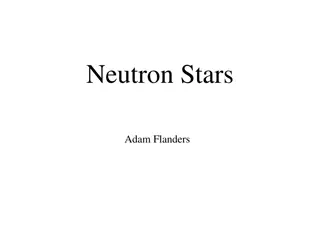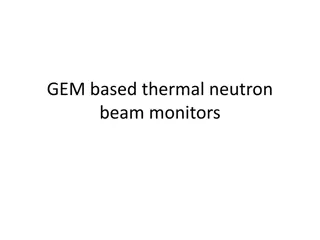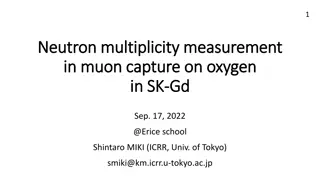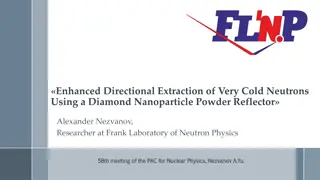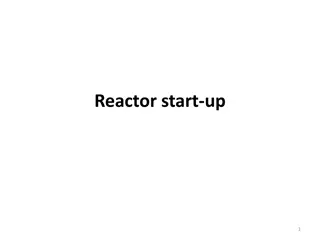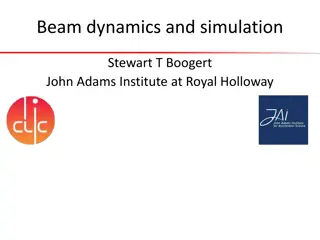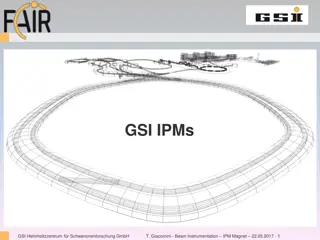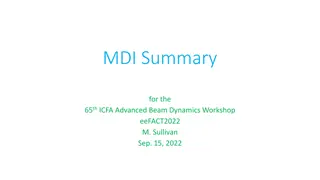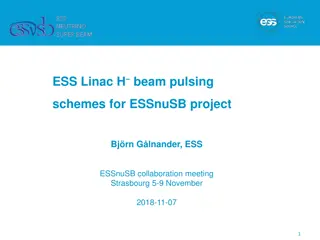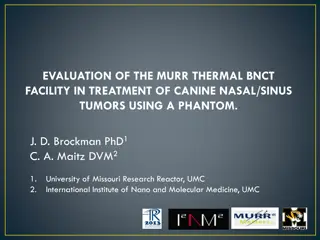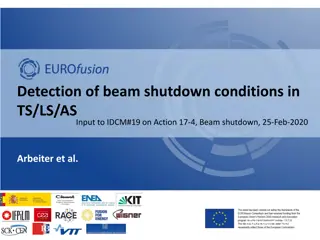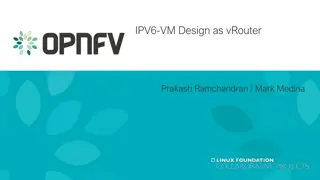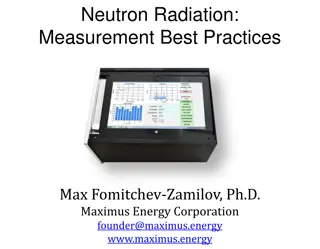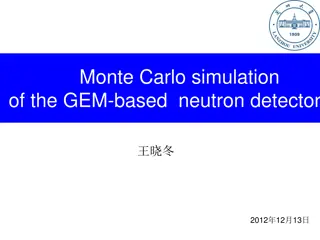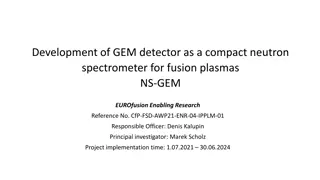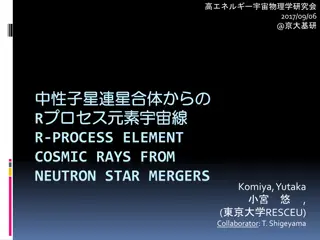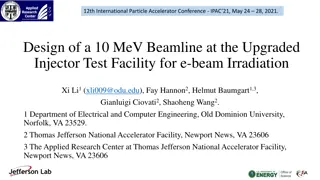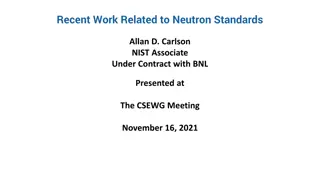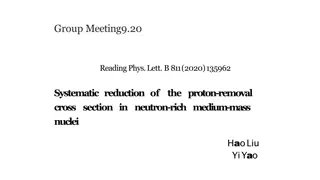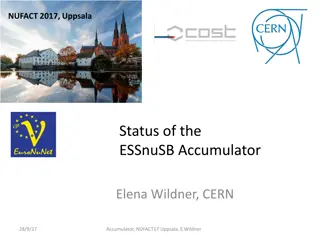European Spallation Source Neutron Instrument Project Overview
The European Spallation Source (ESS) Neutron Instrument Project aims to develop 15 world-leading neutron instruments by 2023. The project involves instrument classes, performance targets, budget considerations, and a planned schedule for instrument commencement. The NSS project scope includes reduci
4 views • 18 slides
Exploration of Single Neutron Transfer on 68Ni at ISOLDE Workshop
Delve into the research on single-neutron transfer on 68Ni conducted by Andreas Ceulemans at the ISOLDE Workshop and Users Meeting in November 2023. The investigation focuses on the significance of studying nickel isotopes, the magicity and collectivity near 68Ni, and the use of shell model calculat
5 views • 26 slides
Exploring Neutron Stars: Discoveries and Characteristics
Neutron stars, initially proposed in 1933, have been the subject of various discoveries and studies. They are characterized by their unique properties such as compactness, high density, rapid spinning, and strong magnetic fields. Neutron stars are predominantly composed of neutrons, with other parti
2 views • 23 slides
Innovative Solutions for Thermal Neutron Beam Monitoring
Cutting-edge detector solutions are proposed for thermal neutron beam monitoring, utilizing various configurations such as head-on bGEM with electronics, bGEM with side electronics, and side-on bGEM TPC-like setups. These solutions offer precise detection capabilities within specified envelope dimen
0 views • 7 slides
Estimation of Dead-Time Loss for Neutron Count-Rates
This study discusses the estimation of dead-time loss for high neutron count-rates and the associated multiplicity correction using multi-channel list-mode data. The numerical method for high count-rate dead-time correction in neutron multiplicity counting is described, focusing on the use of multi-
0 views • 6 slides
Neutron Multiplicity Measurement in Muon Capture on Oxygen in Super-Kamiokande
Explore the neutron multiplicity measurement in muon capture on oxygen using Super-Kamiokande, a water-Cherenkov detector located underground in Japan. Gadolinium was added to enhance neutron tagging efficiency, aiding in Supernova observation, proton decay rejection, and more. Neutron signals are t
0 views • 16 slides
Advanced Fission Experiments at University of Michigan
The University of Michigan, under the guidance of Dr. Sara A. Pozzi, conducts cutting-edge fission experiments leveraging organic scintillation detectors. These detectors offer advantages such as nanosecond-scale response times, energy proportionality, and scalability. The experiments focus on impro
0 views • 4 slides
Enhanced Directional Extraction of Very Cold Neutrons Using Diamond Nanoparticle Reflector
Alexander Nezvanov, a researcher at Frank Laboratory of Neutron Physics, presented a study on enhanced directional extraction of very cold neutrons using a diamond nanoparticle powder reflector. Very cold neutrons (VCN) have unique properties making them ideal for various applications in neutron tec
0 views • 11 slides
Insights into Neutron Stars: Observations and Implications
Exploring the fascinating realm of neutron stars through astronomical observations and the implications for equations of state (EOS). Delve into the mysteries of neutron star properties, measurement results from projects like PREX/CREX, and the significance of NS masses, tidal deformabilities, and r
0 views • 24 slides
Advancing Neutron Sources for Complementary Experiments at DONES
Exploring further potential for utilizing fast neutron sources, the DONES project aims to expand its scope beyond fusion materials studies. The ELAMAT Consortium, spearheading the bid for hosting DONES in Poland, envisions incorporating additional scientific areas for complementary research. Complem
1 views • 7 slides
Understanding Reactor Start-up and Neutron Multiplication in Subcritical Reactors
Reactor start-up is a crucial operation that transitions a reactor from a subcritical state to a critical state by carefully adjusting reactivity levels. In a subcritical reactor, the neutron density should decrease over time but may not reach zero due to certain factors. Neutron multiplication fact
0 views • 66 slides
Exploring Dark Matter in Neutron Stars
Investigate the interaction of dark matter within neutron stars, comprising approximately 25% of the universe's total matter. The nature of dark matter assumptions, its distribution within neutron stars based on fermionic or bosonic properties, and the implications for self-interacting fermionic and
0 views • 22 slides
Advancements in Beam Dynamics and Simulation at John Adams Institute
Explore the latest research highlights in beam dynamics and simulation conducted by Stewart T. Boogert at the John Adams Institute in collaboration with Royal Holloway. Learn about the groundbreaking work in wakefield measurement, achieving a beam size of 65 nm, development of beam delivery simulati
0 views • 15 slides
Critical Issues in CLIC Drive Beam by Working Group 6 at LCWS11
Issues identified in the CLIC Drive Beam project include RF stability and reliability, beam current stability, RF deflectors in combiner rings, synchrotron radiation power, beam dynamics, operability concerns, machine protection, and beam synchronization challenges. Key areas requiring attention inc
0 views • 5 slides
Beam-beam Effects in Future Hadron Colliders Workshop
Explore the beam-beam effects in the SPPC and future hadron colliders, presented at the International Workshop on High Energy Circular Electron-Positron Colliders. The workshop covers weak-strong beam-beam simulations, collision models, and parameter values for the SPPC. Detailed discussions on the
0 views • 32 slides
Analysis of Beam Tracking in IEEE 802.11-19/0007r0 Document
The document "January 2019.doc: IEEE 802.11-19/0007r0" discusses the necessity of beam tracking in the 11md draft. It explores whether beam tracking should be mandatory or optional and provides insights into DMG beam tracking procedures for both TX and RX in wireless communication. The document emph
0 views • 11 slides
Revolutionizing Oral Care with Beam Connected Toothbrush and Insurance Plan
Beam Technologies offers the Beam Brush, a smart toothbrush that integrates with a dental insurance plan to promote preventative oral care, reduce costs, and provide valuable insights on oral health. The Beam Brush and accompanying app track and reward good oral hygiene habits, detect oral diseases,
0 views • 5 slides
Overview of Beam Instrumentation at GSI
Beam instrumentation at GSI, specifically focusing on IPMs, plays a crucial role in managing various aspects of accelerator operations. The images and descriptions provided highlight the use of IPMs for setting up different ion sorts, beam width monitoring, cooling and injection optimization, and fa
0 views • 28 slides
Advanced Beam Diagnostics and Control Systems in Beam Physics
Cutting-edge detector technologies like KAPTURE and KALYPSO are revolutionizing beam diagnostics with ultra-fast Terahertz detectors and advanced line-camera systems. The POF III and POF IV projects focus on extreme beam control and diagnostics, aiming to probe femto-scale dynamics of relativistic p
0 views • 8 slides
Overview of Electron/Positron Injector Linac Upgrades at KEK
The recent status of the Electron/Positron Injector Linac at KEK, presented by Kazuro Furukawa, highlights the mission to achieve 40 times higher luminosity in the SuperKEKB collider. The upgrades include low emittance, low energy spread injection beams with higher beam current, new high-current pho
0 views • 23 slides
Ion Beam Intensity Enhancement Through Electron Heating in Collider Experiments
The study discusses electron heating of ions in collider experiments at the Collider V. ParkhomchukBINP facility in Novosibirsk. It explores the effects of electron cooling on ion beams, ion beam oscillations, losses, and ion beam intensity enhancement. Various factors such as ion charge, classical
0 views • 9 slides
Highlights of the 65th ICFA Advanced Beam Dynamics Workshop
The 65th ICFA Advanced Beam Dynamics Workshop featured insightful presentations on high currents, luminosity, and beam behaviors. Topics included beam pipe scrubbing, non-gaussian beam tails, and detector backgrounds. Presenters discussed progress in FCCee design, focus magnets, and beampipe concept
0 views • 32 slides
Achieving High Average Beam Polarization in Particle Colliders
Detailed discussion on achieving high average beam polarization in particle colliders like CEPC, focusing on longitudinal polarized colliding beams, beam polarization requirements, basic formulas, and strategies for maintaining beam polarization during physics runs. Emphasis on scenarios involving s
0 views • 16 slides
ESSnuSB Project - Linac Upgrade for Neutrino Beam Generation
Explore the ESSnuSB project's linac upgrade featuring beam pulsing schemes and modifications, aiming to provide an additional 5 MW of beam power for neutrino generation. The upgrade options, pulse structure, beam parameters at 2.5 GeV, and different pulsing schemes are detailed with images and descr
0 views • 10 slides
Electron Lenses in Particle Accelerators: Advancements and Applications
Explore the use of electron lenses in particle accelerators for space-charge compensation, Landau damping, halo collimation, and beam-beam compensation. Learn about their history, applications in Tevatron and RHIC colliders, and current research areas. Electron lenses have shown promise in enhancing
0 views • 44 slides
Update on UE Beam Assumption for RRM Test Cases in 3GPP Meetings
The latest developments in 3GPP meetings regarding UE beam assumption for RRM test cases are outlined. Discussions include the need for UE beam type assumptions, updates to test cases for FR2, and upcoming presentations focusing on specific test cases and beam assumptions per test group. Test purpos
0 views • 9 slides
Overview of Mu2e Slow Extraction Workshop at Fermilab by Vladimir Nagaslaev
This content discusses the Mu2e project at Fermilab, focusing on slow extraction techniques for beam delivery. It covers beam facilities, characteristics of Muon Campus, design requirements, beam losses, new MARS simulations, and losses in the extraction beam line. Details include beam kinetics, spi
0 views • 17 slides
Evaluation of MURR Thermal BNCT Facility for Canine Nasal/Sinus Tumor Treatment
The study evaluates the MURR Thermal BNCT Facility's effectiveness in treating canine nasal/sinus tumors using a phantom. The facility, located at the University of Missouri Research Reactor, offers Boron Neutron Capture Therapy (BNCT) under the direction of Dr. Fred Hawthorne. Key features include
0 views • 21 slides
Analysis of Beam Shutdown Conditions in IDCM Input to Action
This comprehensive document explores the detection of beam shutdown conditions in the context of an IDCM input to Action. It covers scenarios requiring beam shutdown, available detection techniques, sensor compilation, and allocation of detection techniques. The analysis delves into the power source
0 views • 28 slides
Overview of CAIN Particle Tracking Code for High-Energy Colliders
CAIN is a particle tracking code used for high-energy collider simulations since 1984. Initially named ABEL, it evolved to include beam-laser interactions for gamma-gamma colliders. The code, written in FORTRAN 90, handles beam-beam and external fields, with a structure where all particles are store
0 views • 17 slides
Overview of vRouter Implementation in Openstack Neutron
Virtual router (vRouter) is a crucial component in network virtualization, with applications in cloud environments like Openstack Neutron. This article delves into the concept of vRouter, its importance in IPv6 implementations, and the utilization of VM-based vRouters. It also explores the current s
0 views • 12 slides
Neutron Radiation Measurement Guidelines and Techniques
Understanding neutron detection basics, absorption cross-section, moderators, positioning, and common detector types is crucial for accurate measurements. Neutrons vary in energy levels, requiring specific detection techniques. Thermal neutrons are easier to detect than fast ones, with materials lik
0 views • 34 slides
Monte Carlo Simulation of GEM-Based Neutron Detector and Detector Performance Analysis
A detailed exploration of Monte Carlo simulations for GEM-based neutron detectors, investigating their detection efficiency and performance characteristics. Various detector designs and concepts, including multi-layer converters and GEM detectors, are discussed, along with simulation results on sign
0 views • 12 slides
Development of NS-GEM Neutron Spectrometer for Fusion Plasmas
This project focuses on developing a compact neutron spectrometer, NS-GEM, using gas electron multiplier detector technology for fusion plasma applications. The goal is to achieve high energy resolution, low sensitivity to γ-rays, and high count rate capabilities for accurate neutron measurements.
0 views • 22 slides
Neutron Star Mergers and Ultra Heavy Element Cosmic Rays: Exploring Their Connection
Delve into the intriguing link between neutron star mergers and the synthesis of ultra heavy element cosmic rays. The rapid neutron capture process, known as r-process, plays a crucial role in creating elements heavier than iron through events like neutron star mergers and core-collapse supernovae.
0 views • 19 slides
Design of a 10 MeV Beamline for E-beam Irradiation at UITF Wastewater Facility
This paper discusses the design of a 10 MeV beamline at the Upgraded Injector Test Facility for electron beam irradiation, focusing on wastewater treatment for environmental restoration. The use of electron beam irradiation is highlighted as an effective method to remove pollutants like 1,4 dioxane
0 views • 9 slides
Recent Advancements in Neutron Standards Evaluation
Recent work by Allan D. Carlson, a NIST associate under contract with BNL, was presented at the CSEWG meeting discussing possible changes to neutron standards and showcasing important measurements, such as H(n,n)H angular distribution data by Jiang et al. and 6Li(n,t) reaction measurements by Bai et
0 views • 15 slides
Systematic Reduction of Proton-Removal Cross Section in Neutron-Rich Medium-Mass Nuclei
Single-nucleon knock-out reactions in neutron-rich medium-mass nuclei were studied to investigate the reduction of proton-removal cross section. Short-range correlated nucleon pairs, especially protons, were found to impact the probability of single-proton removal processes. Experimental measurement
0 views • 8 slides
Advanced Techniques for Beam Position Monitoring in Project Meetings
The project meeting on March 22, 2018, focused on detailed analyses and methods for beam position monitoring, calibration techniques, and resolution enhancement in beam position measurements using innovative waveform vectors. The process involves calculating position for a cavity BPM, waveform analy
0 views • 25 slides
Challenges and Design of High-Intensity Accumulator for Neutrino Experiments
The presentation discusses the challenges faced in designing an accumulator for high-intensity particle beams in neutrino experiments at ESS Lund, with a focus on beam loss management, injection efficiency, and intense beam physics issues. The design considerations include beam holding capacity, bea
0 views • 30 slides


